
Griffiths, Bulletin of the Torrey Botanical Club 43(2): 92, 1916
Holotype; Isotype; Painting (Smithsonian Institution); Painting. Painting of fruit. NOTE: The holotype specimen is remarkable because it contains two different cladode types. Only the cladode on the left conforms to the original description of this Opuntia and plants found near the type locality. Also, the cladode on the left agrees with the isotype specimen. Therefore, we accept the pad on the left as the correct holotype. The pad on the right is unidentified but may be O. gomei, a more southerly species.
O. anahuacensis is different from O. stricta, but they are both beach Opuntias.
O. anahuacensis is different from O. bentonii, but they are both beach Opuntias.
Original Citation
What is Opuntia anahuacensis?
Opuntia anahuacensis is a prickly pear cactus of sandy soils associated with the southwestern Louisiana and eastern Texas along the aeolian dunes of the Gulf of Mexico. The plants are 30-67 cm tall, but multiple plants can form large horizontal, impenetrable thickets several meters across.
Details
The cladodes are about 10-15 cm wide and up to 25 cm long; they are obovate, strongly rounded at the apex, and taper demonstrably to the base, suggesting a neck. Pads of this prickly pear can have spines or essentially no spines. Often there are usually no more than 1-2 spines per areole on this Opuntia. If there is a spine, it is often 2(3) cm long and porrect. If there is a second spine, it is shorter and deflexed. Spines are yellow when new but may fade to whitish.
If spines are present on the fruit, they are transient. The stigma is white, and the stigma is bulbous. O. anahuacensis may co-occur with O. bentonii. The latter species is shrublike, not reclining, decidedly more spiny, has yellow stigmas, and visible veins between aeroles.
O. anahuacensis may have all-yellow flowers or red and yellow flowers. The stigma is pale, often white, and the style is bulbous.
O. anahuacensis may be hexaploid.
Other Notes
We found this Opuntia near the saltwater in the foredunes on Galveston Island, Texas, on Bolivar Peninsula, and in the Sea Rim State Park, Texas. It grew on the sand dunes above the highest tide marks. Another report places the plant in southwestern Louisiana. It was originally described from Anahuac, TX, but we could not find it in that area. Additionally, a single, isolated, depauperate population of this prickly pear was found on several acres as much as 15 miles inland, growing in deep, sandy soils along a freshwater, inland waterway. O. anahuacensis may occur along the many secluded miles of the south Texas Gulf Coast, but this is not documented by us. A report by David Martin (iNaturalist) places the species on South Padre Island. Overall, it could be widespread in Texas.
O. anahuacensis is not commonly noticed as a distinct Opuntia species. It may be mistaken for O. stricta, which was reported along the upper Texas Gulf Coast (Pinkava, Flora of North America), but which has never been reported again and which is a distinctly different plant. Some botanists have conflated O. dillenii with O. anahuacensis (Anderson, 2001). Like O. stricta, we have never observed O. dillenii in Texas.
Though it is associated with beach areas, this prickly pear does well in gardens where it can form a large, wide plant if not kept in check. It may be cold-hardy to USDA hardiness zone 7, but it comes from an essentially frost-free environment immediately along the coast.
O. anahuacensis is an invasive plant that has colonized the shores of many Mediterranean countries.
For more information, see:
Ćato S. and Bogdanovic S. (2023) Euphorbia hypericifolia L. and Opuntia anahuacensis Griffiths: two new, potentially invasive species in Croatia, 5th Croatian Symposium on Invasive Species. (poster No. 40).

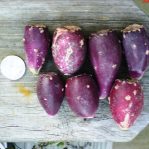
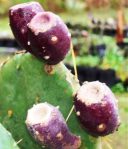
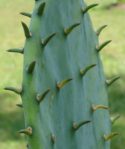
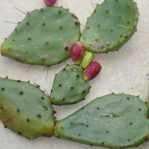

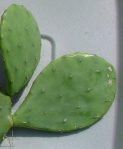




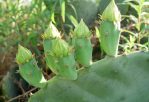
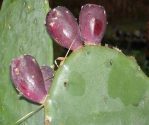
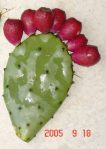
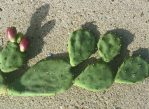
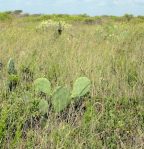
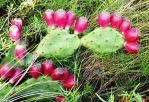
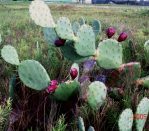
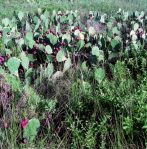

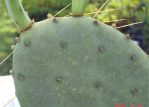
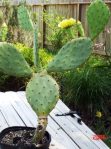
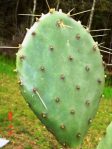
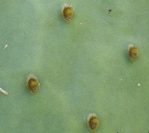
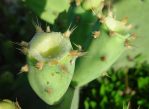
Thank you. So far no email. Knowing of your site will be helpful.
Thanks for visiting.
Does to fruit taste different from San Antonio Rickey Pear?
Does to fruit taste different from San Antonio Prickly Pear?
Hi J.R.,
I don’t know about the fruit of O. anahuacensis. I’ve never tried to taste it. But, I can assure you it is very slimy when you cut into it.
Joe
I recently obtained cuttings of a similar looking prickly pear. The cuttings were roughly 10-12 in. tall and 5-7 in. wide. The areoles appear to be brown with large, painful glochids. It has about the same number of spines per nopal as O. anahuacensis, the spines are light yellow color. The base of nopals often appear to be a yellow color as well. The innards of the nopals have a bizarre and nauseating odor and are slimy as you described. The tuna are red and look just like O. anahuacensis. But the only thing preventing a match is that I obtained the cuttings in zone 6 in an unprotected area of Cincinnati. Are there any Opuntias that match this description?
Hello,
What is the basic difference between O. stricta and O. anahuacensis? In Greece there are many records of Opuntia humifusa, very few of O. Stricta and none of O. anahuacensis. I believe the three are much confused in my area.
Thank you